Australian Tesla Powerwall 2 Review
Late last year, Elon Musk surprised everyone by announcing a new version of Tesla’s less-than-a-year-old Powerwall home battery system, with double the capacity for the same dough….the other players in this industry must have been gnashing their teeth, but bravely soldiered on with the expectation that “it’ll take them forever to deliver”.
Not so – my Powerwall2 was installed yesterday, one of the first in New South Wales, Australia – read on for the blow-by-blow and decide if you also want to be free from power blackouts and 3-figure power bills.
What is a Powerwall anyway?
If you don’t yet know what a Powerwall2 is, read this section – if you do, skip to the next heading.
Simply put, it’s a slim, no-maintenance, weatherproof and near-silent rechargeable Lithium battery system with the front profile of a bar-fridge, located near your power board, paired with a Gateway box that manages power flows from and to your home and the battery system.
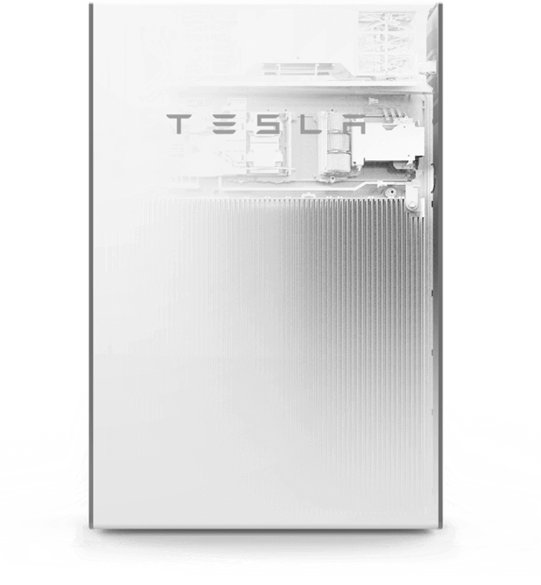
Inside it, there’s heaps of cylindrical battery cells, assembled into packs, which are similar to the ones used to power the upcoming Model3 electric car.

They are made in Tesla’s Nevada Gigafactory, and packaged inside a shiny white-painted steel enclosure, along with a charger, inverter, and water-cooling system.
The system has an installed cost of just over $10,700 in Sydney, and you can get one with around a 2 month lead time today.
It’s designed to save the output of your solar power system during the day, so when the sun sets (or when your solar generation falls away), it will power your entire house until it’s nearly discharged. And, if there’s a power blackout, the PW2 switches to powering your house from the battery instantly, so you still have power for your entire home until power gets restored, or the battery runs down (not if the sun is shining though!).
It’s capable of supplying 13KWhr, or so, of stored energy when fully charged, which for most homes will carry them through the night, and therefore saving you the cost of the power you would otherwise have to buy. The power level it can handle is 5kW Steady, 7kW Peak (30 Amps per PW2), enough to run most kitchen appliances, a split-system airconditioner, or even charge a short-range electric car (such as a Mitsubishi Outlander PHEV, which only draws 2KW to charge, taking 5 hours).
For me, with 4.8KW of paid-off solar on my roof, a rough calculation says the PW2 could pay for itself in 6 to 9 years, and it’s warranted for 10. If you don’t have solar power, it’s not for you, but given prices for power are only going to rise, you should consider getting solar cells anyway, if you own your home and have roof space available. I’ll go through the financial aspects in detail towards the end.
The install process
I reserved a Powerwall2 via Tesla’s site in October last year – it’s a quick and painless process, pricing is entirely available online, it’s transparent and up front, so you have no need to chase around for quotes. This is a significant advantage Tesla has, as there’s more than a few cowboys in this industry in Australia. Tesla’s checkout took a $500 deposit by credit card at order time, they followed up with several phone calls over the intervening months, a contractor (Downer EDI) did a site visit a few weeks before install, and then Tesla requested payment by bank transfer for the balance of the $10k this week.
7.00am: Two tradie vans arrived promptly as promised, from a local solar outfit called Flash Point Solar in Punchbowl. Another guy from Downer also arrived to supervise. As it turns out, this was the first install for all of them.
The gear came in two large cardboard boxes – the Gateway, and the Powerwall2 itself. The PW2 weighs over 125kg (290 pounds says the sticker, but another one next to it says 67Kg, so clearly the whole “metric system adoption” in the US still has some bugs in it), with the result that a trolley is needed to shift it around. It is just wide enough to fit through a standard door.
8.00: Hardest part so far is figuring out where the wall studs are for the mounting bracket. My house has plastic cladding, so they can’t easily find the studs. .
The PW2 is expected to rest on the ground on feet, and the bracket is meant to prevent it from tipping over.
8.30: Looks like they are working it out as they go – 5 guys here now – 3 from Downer, of which 2 were here just to learn, and they said they had done some training with a prototype.
9.00: Mounted, and then had to remove it.
They ended up putting a big piece of ply against the cladding to help spread the load (and give them more opportunities to bolt into the elusive frame studs). Since they didn’t allow for the height of the PW2 bracket placement before bolting the ply to the wall, the ply ended up sticking out beyond the top of the PW2. The mounting bracket has a silver spring clip in the middle of the “T” that locks the frame to the PW2, and the clip can only be accessed with something very long and thin, like a spring-steel ruler. I made them a feeler to dismount it, (Tesla didn’t provide any tools with the PW2), and they pulled it off, and cut the ply down so it wasn’t visible.
9.15: Apparently all the cables go in the side, to a junction box under the cooling radiator – this is a decent size one, like an inter-cooler from a car. They don’t need access to the back of the unit, although there is a wiring gland just visible there, for use with installations that require the cabling to pass through a wall. The black sides are plastic, and clip into place.
9.30: Gateway mounted, now they are discussing how to wire all the cables between the 3 boxes. There is an installer manual on an iPad, and a set of paper manuals, which are mostly safety advisories.
1.30: All cabling done. There is a clamp on the solar active input to measure it’s generation, and the gateway measures the house load from the power cable directly. The PW2 charges only from solar at the moment.
Ken from Tesla arrives to help the installer commission the unit. The Gateway has a built-in Neuros Wifi Access Point (TEGxxxx, username is installer’s email, password is SN#) in addition to a LAN port and a Telstra 3G telco SIM, but the SIM has yet to be activated by Telstra, so Ken connects it to my home Wifi and uses a webpage to update the firmware. He says that the preferred connection method in future is via 3G so they do not need to rely on Wifi availability.
The process of connecting is detailed here: Tesla site To connect to the Gateway, find the Wifi AP TEG-xxx, and connect to it using your SN# as the AP Password. Then wait around 30 seconds, and click through the security warning. To login to the settings page, use your email address and the last 5 digits of the SN as the password.
The installer used an iPad to connect to the PW2 Gateway’s AP, and defined the size of the solar inputs, identified my inverter model from a list, selected which measuring inputs in the Gateway are monitoring the load and generation, and entered my Tesla account login (you make this when you order, and there’s no ongoing costs involved).
At the end of this, the Gateway’s webpage showed the current state of the home current draw, solar generation, and charging status of the PW2. However, the power consumption figure for the home seemed too high for the few lights that were on, and closer examination of the metering setup in my powerboard showed that the solar net meter is summing the solar generation into the input to the home, so they end up running another clamp into the powerboard to measure the consumption load separately.
2.30: Done – I reckon they could shave off a couple of hours, now that they have the install experience, and if they had a brick wall to mount it on, instead of the foam pillows my house has.
To test the system, I turned on a TV that was visible from the powerboard, and then switched off the mains-input circuit breaker to simulate a power blackout – there was a slight clunking of relays in the Gateway, and the TV didn’t even flicker.
Ken said the switch-over takes only 30milliseconds, which was fine by my running PCs, and if you have the App open, you get a notification in the App’s power-flow display that the house is now running on backup power. Switched on the main circuit breaker again, and with some more clicks, the gateway changed over to the mains about 10 seconds later.
For solar installs here, local rules require any grid-connected solar system to shut down when the grid-power fails, to protect pole-and-wire workers. I expected this to apply with the PW2 as well, but, it isolates itself from the grid when the grid fails, so the solar system stays up to charge the battery and power the home when the grid goes down.
Tidbits
Other than the Tesla app, the only visible sign of the PW2’s operation is a LED light strip down the side of the unit that blinks when there’s a problem, is steady when nothing is happening, and pulses slowly when charging or discharging.
Monitoring: I’ve been monitoring the house load and solar generation via PVOutput for the last 6 years – this service provides a free portal to your house power flows via a webpage and phone app, once you install a small monitor in the powerbox. There is no provision for PVOutput data from the PW2 yet – apparently it generates a huge amount of info, and Tesla are going to expose this at some time in the future, but, Ken said, they are focused on the app experience for now. If you want to see the real-time output on a PC, install BlueStacks (an Android emulator) on your PC, and run the Tesla app on it. (Update 7/12/17: PVoutput integration has been done – see the walkthrough for setup here). (Update 26/03/18: and now Windows 10 App)
As only my dog is at home during workdays, my home’s generation was mostly exported up to now, and the majority of consumption occurred at night, so my home represents an ideal use case for the PW2. In the graph above, the green line is instant solar output, and the red one is instant consumption, with the shaded areas representing totals for each.
Update 17/07/17: I’ve found that the Gateway has a basic WebUI that gives instant power flow information. If your Gateway was connected by your LAN or Wifi, you get this info without using the App.
To do so, go to your router and find out the IP address it assigned to the Gateway (it’ll be the device with a long alpha-numeric name that ends in the serial number of your PW2). If you type that IP into a browser, it’ll return the UI page, which you can save as a bookmark.
If you only wanted to look at this on your local network, you just need to go to your router’s DHCP setup and make it set the Gateway’s IP address as a static IP, so it doesn’t change if the router gets rebooted or other devices come along.
To get to it outside your network, you can add a port-forward in your router for the Gateway’s IP:80 to your router’s external IP: 8xxx (a random high port not used by anything else). Then just type in your router’s external IP:8xxx into a browser, and you’ll see the Gateway UI from outside your network. If your router supports Dynamic DNS, you can give it a host-name to save having to remember it’s external IP.
There’s a setup option on that page, so advertising the UI location publicly would be a no-no. The setup page is protected by a username/password login, though.
There is extended data available from another Gateway page: http://<local_gateway_ip>/api/meters/aggregates
This is presumably what the Tesla upload to their servers from the Gateway, and could also be used for generating PVOutput data if polled locally by the PVOutput Integration app running on a local PC:
{ “site” : { “last_communication_time” : “2017-08-06T11:49:13.126321338Z”, “instant_power” : -29.25, “instant_reactive_power” : -339.9700012207031, “instant_apparent_power” : 341.2259723848771, “frequency” : 50.099998474121094, “energy_exported” : 8179.706669868649, “energy_imported” : 1376986.775003202, “instant_average_voltage” : 242.19000244140625, “instant_total_current” : 0, “i_a_current” : 0, “i_b_current” : 0, “i_c_current” : 0 }, “battery” : { “last_communication_time” : “2017-08-06T11:49:13.111260463Z”, “instant_power” : 570.0000000000001, “instant_reactive_power” : 120, “instant_apparent_power” : 582.4946351684281, “frequency” : 50.062, “energy_exported” : 351310, “energy_imported” : 423240, “instant_average_voltage” : 242.4, “instant_total_current” : -14.700000000000001, “i_a_current” : 0, “i_b_current” : 0, “i_c_current” : 0 }, “load” : { “last_communication_time” : “2017-08-06T11:49:13.111260463Z”, “instant_power” : 563.3802608789435, “instant_reactive_power” : -253.8965594736822, “instant_apparent_power” : 617.9488500358258, “frequency” : 50.099998474121094, “energy_exported” : 0, “energy_imported” : 1917433.316111111, “instant_average_voltage” : 242.19000244140625, “instant_total_current” : 2.326191234979833, “i_a_current” : 0, “i_b_current” : 0, “i_c_current” : 0 }, “solar” : { “last_communication_time” : “2017-08-06T11:49:13.126421671Z”, “instant_power” : 5.53000020980835, “instant_reactive_power” : 16.540000915527344, “instant_apparent_power” : 17.439969398084553, “frequency” : 50.099998474121094, “energy_exported” : 621691.994444481, “energy_imported” : 1135.7466667032922, “instant_average_voltage” : 242.16000366210938, “instant_total_current” : 0, “i_a_current” : 0, “i_b_current” : 0, “i_c_current” : 0 }, “busway” : { “last_communication_time” : “0001-01-01T00:00:00Z”, “instant_power” : 0, “instant_reactive_power” : 0, “instant_apparent_power” : 0, “frequency” : 0, “energy_exported” : 0, “energy_imported” : 0, “instant_average_voltage” : 0, “instant_total_current” : 0, “i_a_current” : 0, “i_b_current” : 0, “i_c_current” : 0 }, “frequency” : { “last_communication_time” : “0001-01-01T00:00:00Z”, “instant_power” : 0, “instant_reactive_power” : 0, “instant_apparent_power” : 0, “frequency” : 0, “energy_exported” : 0, “energy_imported” : 0, “instant_average_voltage” : 0, “instant_total_current” : 0, “i_a_current” : 0, “i_b_current” : 0, “i_c_current” : 0 }
How long before you can get it: Apparently, there are installs booked here in the “thousands” range. Backlog for hardware is 2 months if you order now. Each team of installers could only do 1-2 installs per day, I reckon.
To some extent, the distributor you are chained to controls how soon the install will take place, due to the varying rules and equipment approval timeline processes they have, which are beyond Tesla’s control, so Tesla is prioritising the installs to customers chained to distributors that have the approvals ready now.
As usual, Elon is stepping on toes in this industry, by making it possible for us punters to reduce our dependence on the energy monopolies – they naturally will do whatever they can to limit the uptake of residential battery storage.
AC vs DC: Whilst Tesla initially talked about both DC- and AC-charged Powerwalls being available, they settled on only doing the AC-charged ones – Ken says this eliminated any issues that might arise from varying DC capabilities of the many different solar arrays used worldwide, since the AC output from an existing solar inverter is fairly standard by comparison. Yes, there’s some losses in converting the AC power to DC in the battery, and back again, but it meant you could also charge from the grid when tariffs are low, simplified certification by power utilities, lower prices due to scaling of one type only, and no requirement for the PW2 installers to have to muck around with rewiring existing solar cabling setups.
Commissioning: Enabling it on the day of install depends on the customer’s energy distributor’s regulations. There is a switch on the battery, and another inside the Gateway to bypass the system.
I’m with Endeavour NSW, who are happy to have the sparkys sign off on it, whereas some other distributors insist on L2-certified inspectors, and such to commission it. Apparently, Endeavour are also fine with up to 10KW of solar on a single-phase home.
Overloads: I asked what would happen if the house current draw exceeded the power output of the PW2 – Ken said the output voltage will begin to drop, and then the unit would reset, to shed the loads and give you an opportunity to switch off whatever is drawing too much – this would be the same scenario as when I popped a circuit breaker last week, as there was a car charging+dishwasher+microwave+column heater all on at the same time, and the load went over 8KW.
Acoustics: it makes the occasional faint “tick”, and a low-pitch whirring sound when the fan runs. You’ll only hear these if you sit right next to it. The fan blows air out the top-right corner, opposite the radiator. It’s quieter than the solar inverter, which always makes a ticking-buzz noise.
Charging: I’ve been asked if there’s ways to control how it charges, so you could possibly use off-peak power to charge as well as solar.
Here’s how I think charging works: There are inductive clamps in the powerbox on the solar active wire and the home load supply wire, which inform the Gateway of the solar output and home load instantly, so it “knows” when there’s a net positive output from the solar array. The PW2’s charger is wired to the combined solar+grid input after the meter, so it could theoretically draw power anytime and charge itself from the grid. But, the Gateway tells the charger to only draw power equal to the difference between the solar output and the home load, so when these sum to zero or below, the charger switches off. Eg: Solar output 2.7KW, home load 0.4KW, so the charger is commanded to pull 2.3KW. That way, it avoids using the grid to charge at your consumption tariff cost.
It also explains why the app display shows tiny flows of 0.1KW or so for a second or two between the solar/grid whenever there’s movement in the home loads/solar outputs, as the charger presumably takes a moment or two to ramp up and down to keep it’s draw below the net solar power available.
I guess that if you were technical enough, you could put a device inline in the solar clamp -> Gateway wire to mimic the measured output of the solar array, and fool the Gateway into commanding the charger to operate, eg during off-peak at night. However, given that it’s reporting to Tesla via the net 24/7, they might eventually notice this suspicious night-time solar “generation”, and give you a stern warning.
Tesla’s blurb mentions that a future software update would enable off-peak charging for people on TOU tariffs anyway, according to a commenter below. All it would require would be software updates: one for the App, so that the user could specify the time-windows for off-peak and how much they would want to top-up, and one for the Gateway, to enable it to keep track of these times vs the battery charge state, so it could make a decision to charge or not, based on time of day. It would be a little tricky to balance this, in that you would not want to completely fill the battery off-peak, because it’ll get topped-up by the solar in the morning. This would be useful in the winter mainly, when you know the solar will not output enough to get a full charge in the daytime. I can get it up to only 60% during the week of the Winter Solstice, so allowing overnight charging to 40% would be useful for me.
Hey, Tesla App developers reading this: Have the App tie into weather forecasts, and preemptively top-up the battery via off-peak if the next day is going to be cloudy/raining.
(Update 23/04/18 – TOU control is possible now, including weather allowances!)
Update 15/08/17: I have learned that you can force the PW2 to charge anytime by switching it to “Backup Only” mode in the App. This makes it charge at 1.7KW till full.
Controlling it: There’s no way to control the battery discharge beyond switching it off with the power switch on it’s side, so you can’t use software to over-ride the default setting, which is “supply power to the home whenever the load is more than the solar AND the battery has more than 5% available”. In the unusual case where you knew that a blackout was scheduled to come at a specific time, you could let the battery charge up, and then switch it off till just before the blackout.
Update 18/06/17: The App now has a “backup only” option under “Customise” that will achieve this.
Theft: Some people mentioned worrying about the unit being knocked-off, since it’s not behind a locked door. I don’t have any way to put it behind one at my home (no garage), but since it weighs 130Kg, random junkies are not going to be strong enough to lift it, and they would need a tow-truck to yank it off the wall, because of the fiddly clip. Given Tesla’s no-advertising policy, I imagine the vast majority of people here would have no idea what this mystery white box on my wall does, or what it’s worth. And, I have a backup security system just in case…
The Tesla ‘phone app
You can download Tesla’s free Android or iPhone app to manage your Tesla cars and Powerwalls. My Tesla app did not have any registered devices in the day after install, and Ken said, at the time, that someone in Tesla USA would need to tick a box. I chased up the Tesla email contact I had for the payment process, and he called back an hour later to say it was done (on a Saturday morning, as well).
Basically, it lets you know if all is well with the system, by monitoring the state of power flows and battery charge state. Herewith some screenshots:
This is the home page you get after signing in. It takes about 5 seconds to fetch the current state when you open the app, and gives a quick glance to see what the battery is doing and how full it is. In this shot, mine is almost discharged, and very little power was used from my solar array today, as it rained most of the day.
This page, from the first menu on the home page, shows the amount of power that you generated yourself for today. The PW2 didn’t really contribute anything yet, being early afternoon when I took this screenshot, and the overall percentage is low as the solar barely covered the house loads, due to the all-day rain. As the end of the day approaches, the PW2 % will start to go up, as it discharges to cover house loads. You can select today, yesterday, or last week from this display.
This is the live power distribution / flow for the home, from the second menu on the home page. The lines only appear between specific circles when there is activity between those entities, the inactive ones are greyed-out, they have animated blobs to show the direction power is flowing, and pressing any of the circles or the graph icon takes you to graphs of that source/load for the current day’s history.
The PW2 charger dynamically adjusts to the varying load presented by the home – the lowest PW2 charge rate I’ve seen was 0.3Kw, and highest was 2.3KW, although that’s probably limited by the solar generation rate, which did not exceed 2.7Kw today, plus the home didn’t dip below 0.4Kw. The updates have a lag of around 5 seconds to real time.
This is the PW2’s graph – you can select today or yesterday. Same applies for each of the other home/grid/solar sources below, and you can multi-select them to overlay all of the on the page at once.
The next shot was taken towards the end of the first non-rainy day. The blue is the home’s consumption (spikes are bar heaters running at night), the yellow hump is the solar output, shading to lime-green where it covers the home load. The green area below the line is the PW2 charging from solar, and the green spikes to the right are the PW2’s discharging contributions.
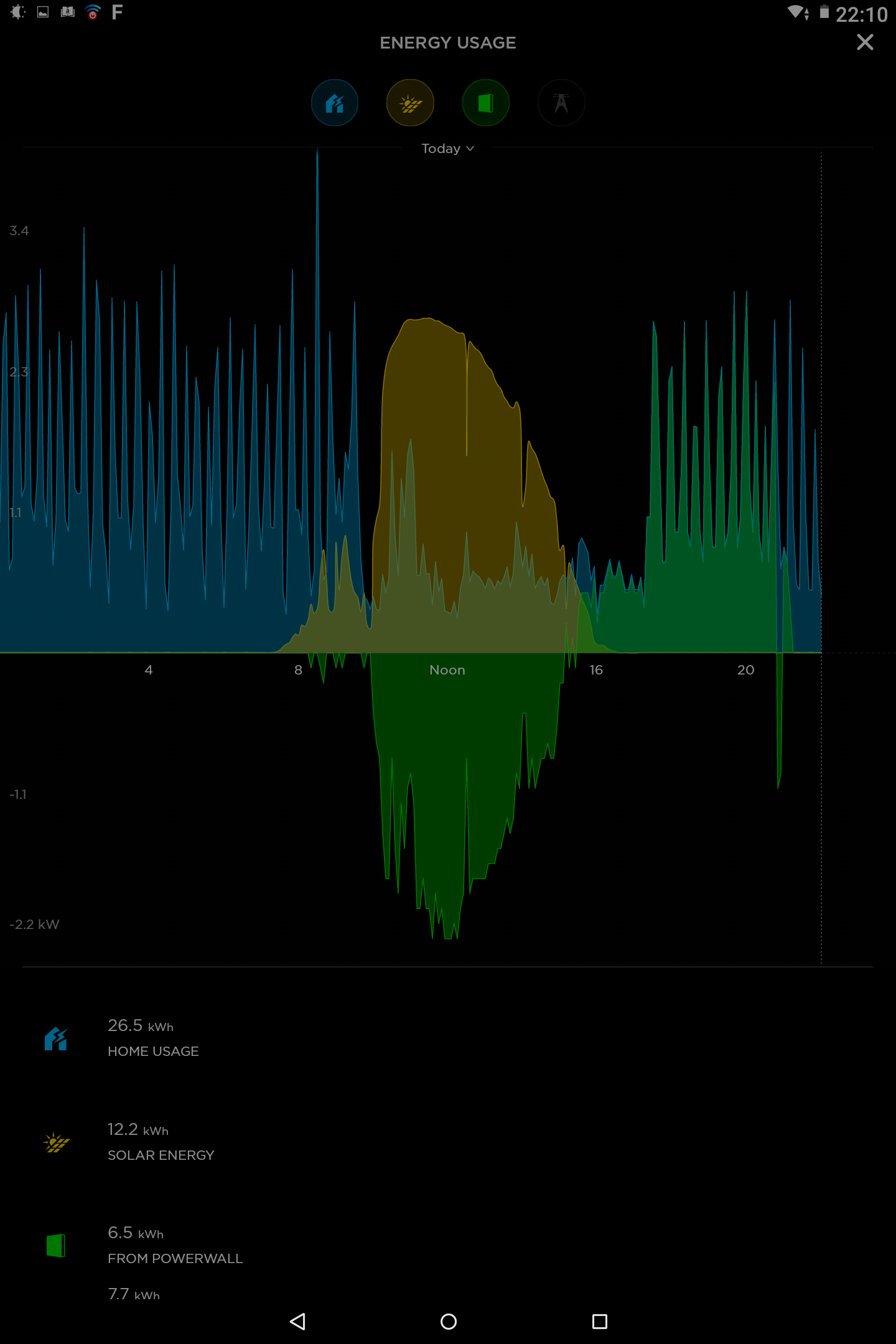
If you scroll down the graph pages, they also show you the running totals for each source/load that’s been selected at the top. I checked the total for the value imported from the grid against what the power retailer showed I had consumed, and it was accurate.
The Backup History is the last of the three homepage options, and shows when the home has been disconnected from the grid, and is running on battery alone.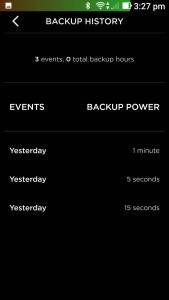
There’s one settings “gear” in the home page, which gives the app version number and enables fingerprint authentication. It’s early days yet, so I suspect they will enable more controls over time, just as they do with the Tesla cars.
Your account at the Tesla website has no usage information about the Powerwall as yet, so the app is the only way to monitor it currently. If you want extensive history for your power generation and use, I recommend using the Efergy clamps to monitor and upload to PVOutput. Again, if you want to see the real-time output on a PC, install BlueStacks (an Android emulator) on your PC, and run the Tesla app on it.
No more blackouts
Now that the PW2 is installed, I probably won’t notice a blackout has occurred, unless the neighbours knock on my front door to ask why my home has lights on when theirs don’t work. I’ll point to the Powerwall, and invite them in to watch Game of Thrones until the power comes back on at their place….
This is what the app looks like when the grid goes down. It had also been showing solar generation with power flows to the home and battery, but that disappeared right as I took this screenshot. The app has a lag of 5 seconds to real-time, and it did show the PW2 both charging and discharging, as well as the solar array still generating.
I was asked in several forums to find out what happens to the solar array during a blackout. The solar array was producing 2.7Kw (500w to home, 2.2Kw to charge the PW2) at the time I shut off the grid, and the inverter didn’t seem to notice the grid disconnect, as it kept on producing power. Prior to the PW2 install, it would always shut off on grid failure, so no power would be available in the home, even when the sun was shining. Now, if the power fails during the day, the solar system still keeps everything running, as far as I can tell.
The installer can define the level of battery power capacity to keep in reserve in case of blackouts, so the battery is never allowed to discharge to a nearly-empty state – I left it at 5%, as we don’t tend to get many blackouts in the winter.
Currently, the PW2’s setup site (accessed through the Wifi AP directly) only allows the installer to specify the backup “save” percentage, so when you have a higher chance of a blackout (in the middle of summer, a hot day with lots of aircons on at night in my street will overload the substation and melt it’s breakers), you can bump up the “saved” percentage to a higher amount, and the PW2 will discharge down to this level only, and then switch back to mains, saving the stated percentage of power to use only if there is a blackout. I’ve yet to play with the AP directly, so will update when I have. Apparently Tesla are going to update the App soon enough, to allow us to define the backup “save” from the app, according to one commenter.
Update 18/06/17: New version of the app has a “Customise” menu at the bottom of the homepage, which leads to a page with + / – buttons for adjusting the reserve backup percentage…it also has option buttons for Backup Only (100% reserved for blackouts) vs Self-Powered (discharge whenever there is a load greater than solar and capacity is above reserve).
I had reason to play with this feature recently: I noticed that on a number of nights the PW2 would discharge completely, then charge up a couple of percent, and discharge again, repeating this “Pogoing” a few times in step with the spiky power loads that bar heaters were causing. I tweaked the backup percentage from 5% to 10%, and this event has not happened since, so I guess that setting a very low backup percentage might be difficult for the PW2 to detect when the discharge goes to far, and as a result it prompts the charger to run at night.
Financial sense?
There’s lots of online debate over whether it’s worthwhile to buy PW2. I judged the PW1 would not earn it’s keep during it’s warranted lifetime, with only 6.4KWhr of storage, but at 13.5KWhr available, the PW2 makes financial sense, in addition to “Greenie” feel-good things like helping offset CO2 and coal pollution.
One way to estimate this is the “cost per KWhr for the warranted lifetime output”. Assuming 13.5KWhr/day x 365 days x 10 years = 49,275KWhr @ $10,700 cost, giving a best-case net cost to me of $0.21 per KWhr used. In my area, AGL charges $0.27 / KWhr for dirty-coal-fired power, or $0.32 /KWhr for “green-ish” power, so it looks like I’m well ahead.
Yes, some of the power that I used to export, (and would otherwise be paid $0.06 / KWhr for), now goes into charging the PW2 every day – this reduces the saving somewhat, to what appears to be break-even. However, keep in mind that the total cost for the PW2’s warranted lifetime output is a fixed figure of $10.7k, whereas AGL had an 8% power price rise in the last year, and they just announced that they’ll be demanding 16% more for NSW, and 18% more for SA customers from next month.
I judged that this trend in power price rises is unlikely to go away soon, as the power distributors are incentivised by the government to spend up big on their networks, because they are guaranteed to recoup those costs, plus a healthy markup, from us punters, by law. As such, this rise in prices will more than outweigh the “cost of finance”, and not fully utilising the 13.5KWh available from the PW2 on cloudy days.
Plus, it’s not like the PW2 will just give up the ghost in exactly 10 years – it’ll probably gently decline in output a little over time, just like the owners of Tesla cars report. In that case, the lifetime net cost of the power drops by nearly 2 cents per year in the first years after 10 years has passed, making the value even better over time. The battery cost for new PW2 units will probably go down a little each year too, but I doubt that it will be more than 10% per annum, given historic increases in battery density are 7% p.a.
Another way to value the PW2’s contribution is to see how many years of it’s power output will take to pay off it’s purchase price – or how many year’s-worth of electricity $10,700 will buy you vs the 10-year warranty term. The problem with this approach is that you can’t reliably guess how much the power price will be in the future, and assuming today’s electricity price will hold for the 10 year warranty term is under-valuing it substantially. Today’s “green-ish” power cost here is $0.32 / KWhr, but we had a 8% price rise last year, and expect 16% for the coming year.
So, assuming we stick with last year’s “just 8%” increase p.a. over the next 10 years, the median power cost for 10 years will be around $0.50 / KWhr. If you cycle 13.5KWhr per day x $0.50, you “earn” $6.75 / day, or $2,460 / year. Divide that into the cost price, and the minimum payback period for the purchase cost of the PW2 is less than 4.5 years.
You could dig further into this, and deduct cost of finance, (mortgage rate – 3.5% p.a.), which results in a $0.41 / KWhr 10-year median price ~ $2,020 / year, and it’s paid for itself in just over 5 years.
If you wanted to include the opportunity cost of the power used to charge the PW2 ($0.06 export tariff x 13.5 KWhr x 365 days), this would reduce the annual “earn” by around $300, bringing the payback-time to just over 6 years. If you expected to get less than the full storage out of it, say 10KW/hr on average (7KWhr in winter, 13.5KWhr in summer), it bumps up the payback time to 8 years. It’s warranted for 10 years, so I justify the purchase price as buying me 8 years of power in advance, with 2 or more years free power and backup protection thrown in. If Tesla enable off-peak charging in the future, this will reduce the pay-back time even further.
The worst case scenario for this calculation method is that it would take as long as the warranty lasts to pay it off. Working that calculation above backwards, assuming a 10-year cost-of-finance-included median price of $0.41 / KWhr, you would have to use only 7KWhr from it per day (half it’s usable capacity), to pay it off over 10 years. So, any day you use more than 7KWhr from the PW2, you are in front.
The guys next door to me have $1200 / quarter power bills, for the same number of people, and a smaller home, than mine (That’s around 37KW / day – they don’t have an electric car, so I guess they might be running multiple bar-heaters, Bitcoin-mining, or growing indoor “plants”, to use that much). I decided a while ago that the only way to win was to make your own power, and the PW2 helps to make use of as much of it as possible.
Update 31/07/17: here’s a meter reading from my July bill:

Note how there’s no Peak (1PM to 8PM) usage at all – only a tiny amount of Shoulder (7AM to 1PM, 8PM to 10PM, and weekends), and so almost all usage is Off-Peak. I’m guessing the tiny amount of Shoulder happened when there was not enough sun to charge the PW2, and more than half of the Off-peak is car charging.
Is PW2 right for you?
Do you own a solar array 3KW or greater in size that’s exporting a lot of power and not getting a big feed-in tariff? Do you consume more than 15KWhr of power daily, and use most of your power in the evenings? If so, PW2 has been designed just for you.
If you have paid-off a solar array on your home already, the PW2 is the best way to maximise the value the array still has. Now that feed-in tariffs are mostly a pittance in NSW, by storing the day’s solar output at the opportunity FiT cost, and using it during peak tariff periods at night, you’ll save $0.25 or more per KW/hr.
If you live in South Australia, where coal-fondling politicians, foreign-owned tax-dodging power monopolies, and inclement weather have come together to create the highest power prices in the world, it’s a no-brainer to get a PW2.
I’ve made a spreadsheet you can download and insert your own values for power costs, FiT, PW2 price, cost-of-finance, and expected cycling usage in here I’ve assumed a paid-off solar array feeds it, and even allowed for observed charging losses, although cycling more than the max value by daytime usage or offpeak charging will wipe them out.
If you have yet to install solar, the rising prices for coal-fired and gas-fired power that are the result of our crappy political situation will make it more and more attractive in the future, to be sure.
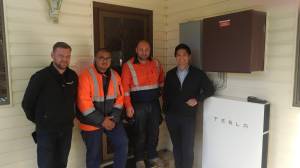

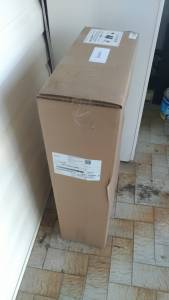
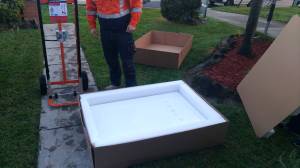
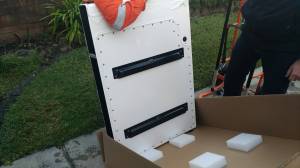
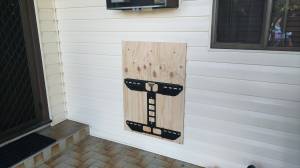
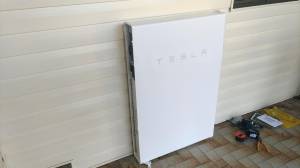
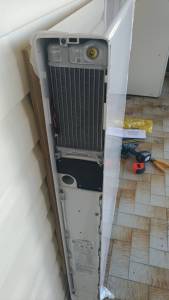
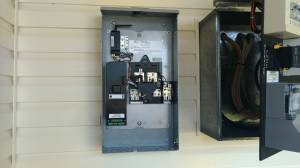

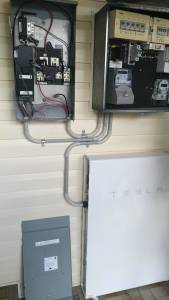
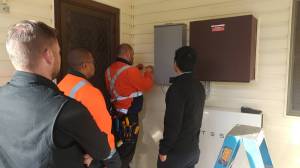
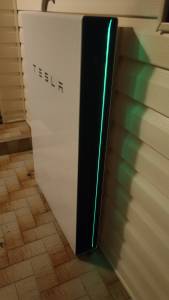
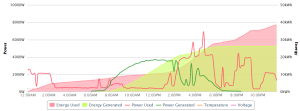
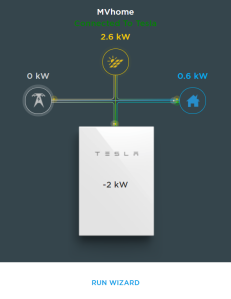
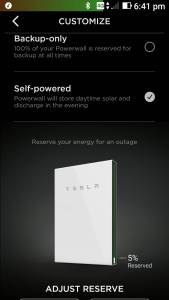
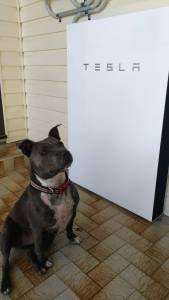
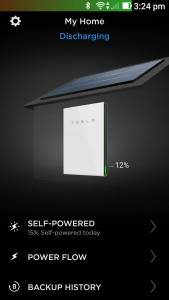
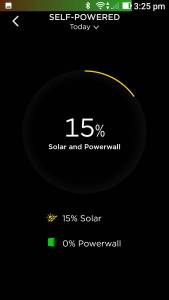
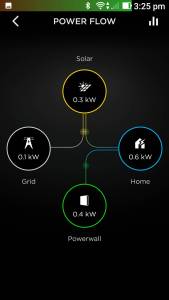
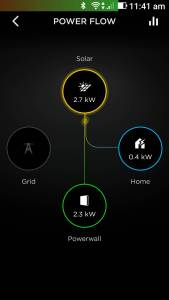
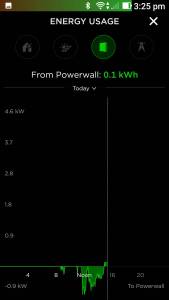
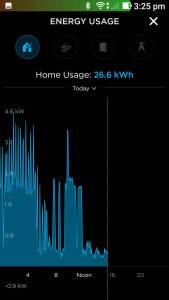

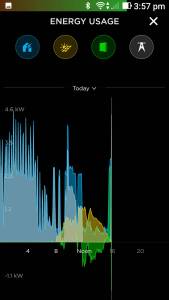

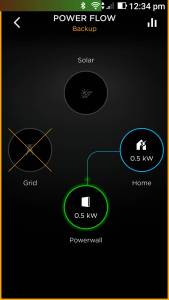
Good article Michael, appreciate the effort in putting this together, anything you can add to installing a PW2 in a 3 phase setup. Trying to work out if clamps are installed on all 3 consumption phases…. and charge/discharge is calculated on the sum of the 3 phases? Little info. In the public domain…
Keep us posted of how you go, looking for someone to lead the way!
Many thanks for the comptehensive heads-up on the PW2. Have had one on order for a couple of months now and was wondering if anyone here in Oz had seen a live one.
I have been told by the Tesla sales person that the PW2 can be charged from solar during blackout. For this configuration, the solar PV inverter would need to be set on the household load side of the Tesla gateway. In a blackout the gateway isolates the home from the grid and the PW2 simulates the grid during blackout so the solar PV inverter keeps generating. The PW2 is supposed to use frequency shifting which will trigger the shutdown PV inverter when the battery is full or loads are less than output of the solar PV, and prevent problems with solar PV causing voltage spikes when there is not enough load to us all the power. Technically this is all possible, and other vendors can do exactly this. But other vendors have highlighted the need for compatible solar PV inverter that can support frequency shifting to throttle down output. The Tesla sales guy suggested all solar inverters approved for install in Australia support this. Can you do a test on your system and see if your PW2 can keep your solar running during a blackout?
Yes, you are correct. I tested this by switching off the grid breaker today, and the inverter kept on pumping out power to the home and battery. I’ve edited the blackout section and posted a screenshot there.
Thanks Michael for your valuable insights.
Due to a combination of large number of blackouts where I live and running a business from home, I am interesting in PW2 for grid stability, and how long I can keep it running in a blackout is important for this. Do you know what triggered you solar PV to shutdown when it did? Was it because you only got around to taking screenshot as it got dark, or did something else happen? If it was before it got dark, did the solar PV restart again before you reconnected the grid?
The solar inverter kept running the whole time the grid was disconnected – I could see it’s display cycling and it’s reported output didn’t change.
The Tesla app showed the solar side contribution varying on and off though, so maybe it’s a reporting issue, as my internet was a little flaky over the weekend and the app had some issues with connecting to the Tesla server reliably every time, or maybe the inverter’s output got throttled, due to the low output from the inverter (only 2.7KW) and varying loads at the home. Hard to tell, as the battery had only a relatively small charge in it at the time of the test, and SWMBO was using a fair bit of power in the house at the time.
Thanks for such a detailed report. Can’t wait for my own PW2 to arrive!
Can I ask if you have any ability to control when the battery discharges? May be a bit of a mute point for anyone on fixed tariff, but I suspect a lot of people with a battery will get the best economics through a TOU tariff. If this is the case, in a lot of cases people might might not want to discharge battery in off peak times, because it is probably better to save power for peak and shoulder periods. Can this be done at all, or is it just a dumb “discharge to cover all loads at all times till battery hits the threshold for power backup”. If configurable, what sort of options do you have? Is this something that can be done by the end user, or only installer?
Finally, do you know if there is any option to be able to tell PW2 to charge itself from grid (ie preparing for high risk blackout event, or charge from off-peak when you know you are going to have a high demand peak event)?
Thanks again for your insights.
There are no controls for the battery other than the “off” switch on it’s side, so you can’t really “save” capacity other than by manually switching it off.
It can only currently charge when there is power available from the solar array, although the way it’s wired suggests the power could come from the mains if Tesla wanted to allow this.
Presumably the charge process is controlled by limiting it to the net power available from the solar array, based on what the Gateway’s clamp senses is coming from the solar array.
I read somewhere that there will be a future firmware update that will enable off-peak charging from the grid. Ah yes, here it is in the PW2 Welcome guide:
Energy Savings
Reduce your electricity bill, if your utility offers a time-of-use rate plan*
*Available at a later date by an over-the-air update
This Energy savings feature would probably allow a stationary generator to be connected to the grid input in an off-grid installation.
Thanks Mike for the blog.
Sure, there’s no mechanical reason why this is not possible, so just needs updated software controls to be enabled to allow the user to specify this. Just like the Tesla cars and their ever-evolving autopilot software….bring it on!
If they do enable this, you could get your PW2 to charge off-peak for a similar cost to the opportunity FiT cost of solar generation.
Thanks Michael. That is pretty basic, and a bit unfortunate Tesla have not allow more control to adjust to circumstances like TOU which I would have through will be the optimum strategy for a lot of people. But I hope these sort of things should just be software updates, and hopefully the functionality is not too long in materialising??
Exactly the write up anyone looking into a Powerwall would want to read. Thanks mate!
Thanks for the write up Michael. I notice the solar installer used, Flash Point, don’t even have a working website…http://www.flashpointelectrical.com.au/ and the pricing you got seems to be low relative to other solar installer offering. Were you offered a lower rate as an early adopter?
I dealt with Tesla for the order and payment – they subbed the actual work out to Downer and Flashpoint. The guys seemed to be regular solar installers, probably working as subbies for others instead of directly marketing themselves.
Hi Michael, you mention that the peak power is 7kW, do you have details on the time it can handle the 7kW for? In addition, is it possible for you to upload the installation manual?
Thanks.
They didn’t mention a time, sorry – only have paper manuals, same as here: https://www.tesla.com/en_AU/support/powerwall
This is really good information. Thanks for making this available. It’s also encouraging they send ( at their cost) lots of people along to get the first one right. Lot’s don’t do that and if it falls over and everyone loses. Cant beat practical hands on experience versus the theroretical
Thank you Mike, Excellent information. I have just had Tesla PowerWall 2 installed. The information from the installers was no where near as comprehensive as your article.
Made great reading and learning.
Regards Peggy
Reblogged this on Ing. Lele's Blog – HeadQuarter.
Thanks for the great review. Question from myself is regarding off peak charging.
There seems to be some uncertainty about the ability of the unit to use “time-of-use rate plans” – on the UK Tesla site it states “with or without solar” which would imply that it can work this way. In the UK winter I was hoping that I could charge during our off peak midnight to 7am period, discharge during the day / evening.
Would be interested to know if the UK version can do this or if a new version of the software is needed.
Thanks in advance for any thoughts on this.
Thanks Mike for your most informative and comprehensive article. I had an additional 5 kW of solar panels (giving me 9kW) and a Tesla 2 installed on 10 July. Due to a problem with the install, the Tesla was not charging or discharging but this has now been rectified by the supplier. Your article was much more helpful than the very brief briefing provided by the installer and has helped me better to understand the operation and relationship of the panels, battery and grid. I feel much more confident about identifying and flagging any problems to the supplier.
Unfortunately , you got a little too technical for me in the monitoring section but I am happy with the data from the Tesla app and the My Enlighten app from Enphase
I would like to throw in a plug for Enphase microinverters fitted to the new solar panels. I am getting twice as much output from the new 5kw array as from the original 4kW panels with a single inverter, tripling total output.
I look forward to seeing how much our power bills will drop. I am also very much looking forward to Tesla providing the capacity to charge the battery from the grid at off-peak times as this will provide greater savings as our peak and shoulder consumption is substantially greater than what solar and battery can generate. The supplier has indicated that grid charging is likely to be available in the next 2-3 months. The delay is apparently due to a requirement for regulatory approval from the power companies, so fingers crossed that they will not delay the process.
Mike:
I’m curious what your thoughts are on the PW2’s noise level. There were some reported issues with the original PW’s noise level, and I haven’t been able to confirm whether that’s been fixed. Is there any audible noise? If so, is it a problem for you? Thanks in advance.
You need to sit within 3 feet of it to hear the whirr of the fan. Otherwise it is silent
Hello, would you be able to confirm for me that your inverter is definitely operating during daytime grid failures after your Powerwall2 installation? Thank you.
Wanna know a secret? Until the Tesla app gets explicit charge-from-grid, you can simply switch to Backup Only mode. With the grid live, your PW2 will top itself up from the grid in lieu of available solar power. You could switch over when going to bed off-peak, then switch back for morning peak tariff.
Yes, I tested this today on a rainy day, charge rate limited to 1.7Kw. Only issue is that you have to time the start with the App outside the peak/shoulder period.
It’s funny you mention the charging clamped to 1.7Kw. I get the same, even from the panels.
My call to Powerwall Support about this has them stumped. I was wondering whether it is a design flaw, an installer error, or a secret spec.
I’m pretty sure the inverter stayed up during the minutes I tested it – the output form it didn’t change. There’s a Youtube video of someone else doing the same test with the same results
https://www.youtube.com/watch?v=HxAbd-kanI8&t=
Rather an unfortunate update on the Tesla UK site, means backup feature not available to us at the moment. This looks like regulatory issues.
Quote
Backup and off grid require additional hardware that is not currently available in the United Kingdom.
Unquote
https://www.tesla.com/en_GB/powerwall
This means my purchase is on hold for the moment.
Hmm it seems like your blog ate my first comment (it was extremely long) so I guess I’ll just sum it up what
I had written and say, I’m thoroughly enjoying your blog.
I too am an aspiring blog writer but I’m still new to everything.
Do you have any helpful hints for inexperienced blog writers?
I’d genuinely appreciate it.
nice information about the powerwall of tesla!
Useful info here .. thanks!
I have had a PW2 for 6 weeks. Having kept track of stats for that time, I can now see a few problems.
* Energy usage screen for last month shows 200 kWh output from PW2 and 169 input!
* On a typical sunny day, the usage graph shows home usage drop to zero for all the time that solar output is over about 1 kW. There is clearly home consumption that is not showing in the app. I’m wondering if CT clamps have been installed incorrectly.
System is 2-phase with Fronius 2-phase inverter. Array is 6 kW. Even though load is split over both phases, most of the stuff that’s commonly used is on the PW2 phase. Inverter seems to be clever enough to send more power to the PW2 phase when battery is charging.
Hi Richard. I just got my powerwall installed a week ago and my data is all over the shop. My only correct value is the solar generation. Every night so far, the app shows that the house is not using any electricity at all even though I am. Im still exporting electricity to the grid even though the powerwall is not fully charged.
Clamps in the wrong spot, let Tesla know
Maravillo post. Gracias por compartirlo…Espero màs…
Saludos
Thanks for sharing the wonderful info on the PW2. We have a PW2 installed with our new home. Is your gateway sending information back to Tesla via your WiFi network? On ours, it was already sending data back to Tesla even though there was no active internet connection at our place. So, presume it is sending the info somehow via 3G/4G. Can I get it to connect to our home network now that we have one active and be able to connect to it? Can it connect to 2 network at once? e.g. Connect to the 3G/4G network at the same time connect to our wireless network? How does it work for your setup? if you lost internet connection to your home, does that mean your powerwall will stop sending data to Tesla?
Hi Francis
My Powerwall communicates via 3G independently of my home internet connection. I installed the Tesla app from the Apple App Store onto my iPhone and can access real time data on what is happening with my solar panels and Powerwall including battery storage state, the power flow between the solar panels, grid, home and battery as well as current and historical data on solar production, grid power usage and feed in from solar to the grid. I love the app and use it daily to check what is going on.
I’m more so interested to see what sort of data the local gateway gives via it’s web ui as compare to the Tesla app. Michael did mention one can get additional data from the local gateway.. i guess in time some hacker will be able to code up a PC app that can grab that data and put out some more meaningful and useful results or an app that will extract the data over time and give us a nice user specified reporting period historical chart.
Monitoring has been done on PVOutput.org:
https://mikesgear.com/2017/12/07/monitoring-teslas-powerwall2-on-pvoutput-org/
You will need to get your PW2 connected to your Wifi for it though.
Hi Michael, really great article! Thank you very much for posting it. I found it very useful. I am planning to install Tesla powerwall2 baterry, but like in 10-12 months. Because I will be closing off the wall where my mitre box is installed, I would like to pre-provision now all the cables. Right now I have all the access to do that.
From your installation I can see what goes between the mitre box and the gateway, although cannot see the internal wiring within the mitre box. What about the cabling of the actual baterry? Does it connect direct to the mitre box or gets routed somehow to the gateway?
Did you need to install some extra mitre(s) by Downer?
I can see all the cables are 16mm, presume battery to the mitrebox us also 16mm?
Could you please kindly help me out? Msnynthsnks!
Paul
Battery charges from the main meter box with thick cables – thick cables also run from the meter box to the Gateway. The battery has small cables for control that go from the battery to the Gateway. There were also two small cables run from the Gateway to the meter box to connect the sensing clamps.
If you look at the pictures, the all the grey ducts, the battery at the bottom, and the gateway on the left were added by them. Couldn’t say what the cable thickness was, but they will provide them regardless.
You don’t need to pre-provision anything, other than a (preferably-shaded and secure) place to park the battery and gateway boxes.
Hi Michael,
Thank you very much for your prompt response.
It looks like those grey and pink cables are some sort of serial cables for the battery management, right?
You are saying they go from the battery to your gateway, so those cables must be routed via your meter box.
Those extra small cables connections will make my envisaged pw2 location problematic, as I was expecting it only would require 3 x 16mm cables: live, neutral and earth from battery to the mains.
My issue is that I am sealing off the wall where my meter box is installed and it will be very hard to lay new cables later without some substantial damage to the wall.
Hence my strong desire to pre- provision the cables. I would certainly expect I should be able to do that,
I am building a garage extension and was planning to install my PW2 in there, the project is about 12+ months away from completion.
My expected power cable length from the battery to the mains would be around 30 meters.
I can place my gateway next to the meter box, it is just the battery itself which I want to be away.
The alternative could be the other side of my meter box, but it is exposed to sun till around 1-2pm daily and is just next to the main entrance.
Is this baterry wall locking mechanism secure? Is there a hookup in the baterry for a padlock like my solar inverter has?
Would, you bo so kind and reconfirmed those grey and pink cables paths and what are they?
Are they Tesla proprietary serial cables?
Thx again for all your help mate!
Cheers – Paul
HI,
I saw the photo https://mikesgear.files.wordpress.com/2017/06/screenshot_20170612-123406.jpg?w=338&h=600 question is why the solar is not working during the grid failure?
The Solar remained up, the inverter showed generation, but the Tesla app screenshot did not. There was around a 5-second delay in the app update, and it was switching between generation and no generation in the app, whilst the inverter produced a continuous output on it’s own LCD.
I test my powerwall 2 to simulate grid failure. Battery level is 98% house load is 400 watts. When i switch off the Grid main switch my Solar Inverter shutdown as well (Islanding). I tried again with 2000 watts home load switch off the main grid switch viola the solar inverter stayed on. 🙂
Time of Use function now available on the Tesla app!
Need to switch to a TOU plan now!!
MIKE – Nice article – very well written for laymen like myself. Seems like TESLA is the one to watch for future implementations of Solar Power generation & storage technological solutions. Thanks! lee